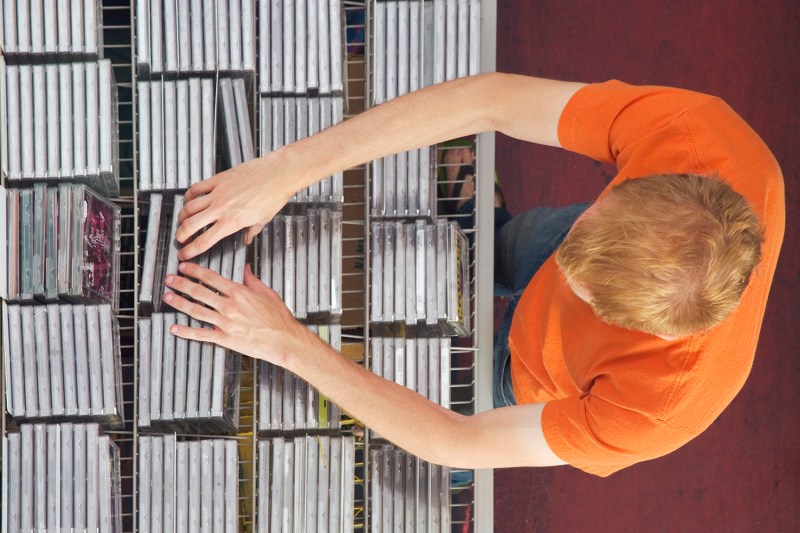Shout out to Tom Ewing at Pitchfork.com for predicting the future. Ewing’s 2012 spoof article that followed a slight bump in cassette commerce found futuristic kids eating jam off of CDs before wiping and playing them. These kids saw “it on an old YouTube clip and became interested in the history of the recently obsolete medium.”
The date of the fictional party? March 2021 — the same year that Media Research Center reports that sales of compact discs have increased for the first time on a year-over-year basis since 2004. This ‘boom’ saw CD purchases inch from 40.16 million units in 2020 to 40.59 million in 2021. While the spiffy circles are certainly not going to surge like it was 1995 all over again, CDs remain a musical medium that still packs live rounds, making an impact as more than just a rainbow-prismatic socio-cultural note.

Why the mass migration from vinyl’s warmer, beloved sound? Discs are efficient, simple, and durable, as the jam kids and thousands of other #cd Millennial and Gen Z TikTokers are discovering. Female mega-acts and K-pop bands mark the rise along with a nostalgic interest in Generation X jukebox heroes. While brand new CDs still run anywhere from $13 to $35 a pop like they did in the 1990s, used and off discs alike can be from $10 to free.
During its ascension, the compact disc proved much more convenient than a cassette for creating mixes (sometimes even of the same album) in addition to access to up to 100 albums or more all at the click of a remote. By extension, disc players are less labyrinthine than vinyl — a huge plus for casual listeners tired of messing with stereo components, styluses, needles, and flipping a plate every 20 minutes. All CDs required are popping them in and pressing play. There’s even a personal connection with the little booklets inside the cheap plastic case, especially when bands made the effort to include lyrics, photos, and stories.
This portable consumption created a boom never before experienced in the audio industry. According to the Recording Industry Association of America’s U.S. Sales Database, CDs dominated the market from the mid-1990s into the early 2000s. From 1999 to 2001, revenue reached nearly $13 billion in 1999 and 2001 and peaked in 2000 at $13.2 billion. From 1996 to 2006, the laser-read disc was an incomparable force, reaching a 2002 acme in comprising 96% of the marketplace — the most popular physical format the U.S. has ever seen. Then Napster came. And in 2003, iTunes arrived.
Related Guides
- Best Indie Albums
- Best Songs About Being a Man
- How To Build a Fire
- Longest Field Goals in NFL History
Audiences primed for audio accessibility shifted to online offerings that began with illegal downloads as sales of online songs started slowly. In 2005, paid subscription services stacked up only $149 million, only 1.2% of a $12.3-billion marketplace. By 2015, this number was up to $1.2 billion and 17% of the industry, surpassing the CD as the country’s preferred medium. The next year, online music platforms totaled $2.2 billion, accounting for almost 30% of all sales. This shift accompanied a market shrunken by close to half in ten years, leaving behind an eviscerated American enterprise, corpses scattered across a sector’s bloody battlefield.
Local stores died in the field as music giants fell from lofty heights. Tower Records lost $10 million in 2000, $90 million in 2001, and in 2004, closed its last U.S. store. Borders Books & Music stores shuttered soon after the company was forced to liquidate in 2011. Sam Goody music shops, which first opened in the 1940s, survived until 2012 when their last stores either shut down or converted into other brands. Best Buy and Target stopped carrying the jewel boxes altogether by 2018. In 2020, RIAA recorded that CD sales reached only $483 million — a massive crash, with the scattered pieces amounting to only a 4% market share.
CDs, of course, aren’t innocent themselves, crushing the vinyl records industry into denuded wax. Ironically, it’s these very same glossy black plates helping to fuel compact disc’s minimal yet measurable pulse in 2022.
In 2015, vinyl was back, exceeding sales last seen more than 25 years ago. Old-yet-new again singles and LPs have staged a surprising comeback in the last few years. Total revenue almost doubled from 2015 to 2020, from $333 million to $620 million. With giant retailers like Walmart, Target, and Amazon now embracing LPs, a consumer push is stressing a wobbly and aged infrastructure. There’s only so much manufacturing equipment to meet demand. Squeezed pressing plants shut down as pandemic lockdowns disrupted supply chains. Turnaround times for independent artists now range from eight months to a whole year for vinyl releases.
Responding to an ever-shifting landscape, big acts like Kanye West, Ariana Grande, Taylor Swift, and K-pop stars BTS are pumping out CDs to drive sales upon album releases. Adele’s new album sold 898,000 discs, alone accounting for over half the bump in CD sales, according to MRC’s 2021 U.S. Year-End report. (MRC Data, formerly Nielsen SoundScan and Nielsen Music Products, is a music industry analytics firm.)
What this means in the greater scheme of things almost assuredly is not a return to boom times for the humble compact disc. Rather, what we see is the staying power of an anachronistic format that still retains some heft as a nostalgic, complementary attraction — a cheap alternative that maintains a distinct character. Not a bad deal for something you can still hold, program, and eat a sandwich from.
Read More: Here Are the Top New Music Releases for January



